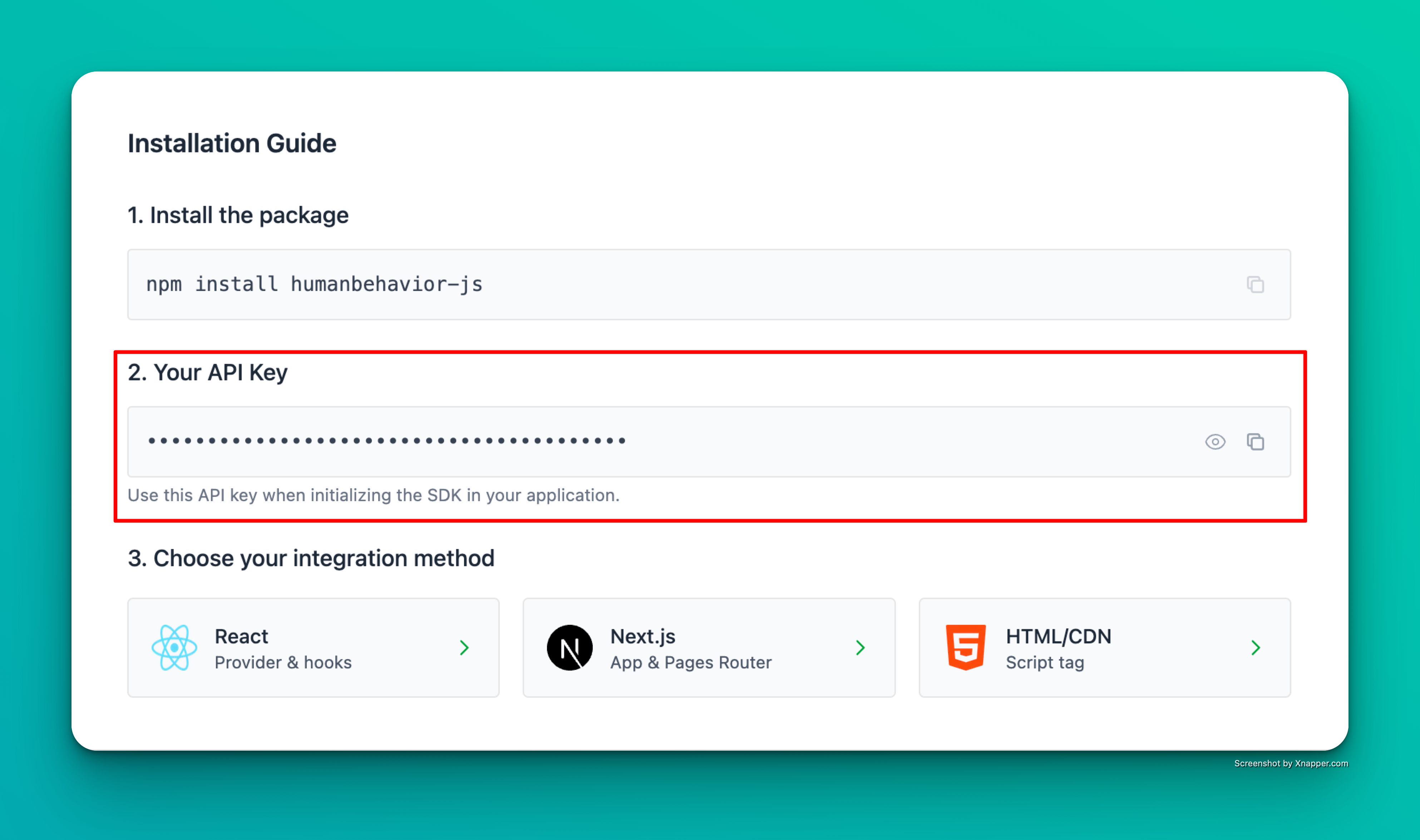Quickstart
Human Behavior works seamlessly to record sessions on your React app.
Show How to get your API Key
How to find your Public API Key:
Flow: Project Home → Integrations → Human Behavior SDK → Kebab Menu → Configuration → Public API Key

Example screenshot – your actual API key will be different.
Step 1: Installation
npm install humanbehavior-js
# or
yarn add humanbehavior-js
Step 2: Environment Variables
Create an environment file (.env) with your API key:
# For Vite projects
VITE_HUMANBEHAVIOR_API_KEY=your-api-key-here
# For Create React App
REACT_APP_HUMANBEHAVIOR_API_KEY=your-api-key-here
Step 3: Basic Setup
Wrap your app with the provider
Use the React provider for the best integration and automatic tracking:
import { HumanBehaviorProvider } from 'humanbehavior-js/react';
function App() {
return (
<HumanBehaviorProvider apiKey={import.meta.env.VITE_HUMANBEHAVIOR_API_KEY}> {/* For Vite */}
{/* OR */}
<HumanBehaviorProvider apiKey={process.env.REACT_APP_HUMANBEHAVIOR_API_KEY}> {/* For Create React App */}
<div>
<h1>My React App</h1>
{/* Your app content */}
</div>
</HumanBehaviorProvider>
);
}
export default App;
That’s it! The SDK now automatically tracks user interactions, navigation, and console events. Everything past here is optional.
Usage in Components
Track Custom Events
import { useHumanBehavior } from 'humanbehavior-js/react';
function MyComponent() {
const tracker = useHumanBehavior();
const handleClick = () => {
tracker.customEvent('button_clicked', {
componentName: 'MyComponent',
buttonId: 'submit-btn'
});
};
return (
<button onClick={handleClick}>
Submit
</button>
);
}
Alternative: Manual Initialization
If you prefer manual setup, you can initialize the tracker directly:
import React from 'react';
import { HumanBehaviorTracker } from 'humanbehavior-js';
function App() {
React.useEffect(() => {
// Initialize the tracker once globally
const tracker = HumanBehaviorTracker.init(process.env.REACT_APP_HUMANBEHAVIOR_API_KEY);
}, []);
return (
<div>
<h1>My React App</h1>
{/* Your app content */}
</div>
);
}
export default App;
Data Redaction
Configure data redaction for sensitive information:
import { HumanBehaviorProvider } from 'humanbehavior-js/react';
function App() {
return (
<HumanBehaviorProvider
apiKey={process.env.REACT_APP_HUMANBEHAVIOR_API_KEY}
options={{
redactionStrategy: {
mode: 'visibility-first' as const
}
}}
>
<div>
<h1>My React App</h1>
{/* Your app content */}
</div>
</HumanBehaviorProvider>
);
}
Runtime Redaction Control
import { useHumanBehavior } from 'humanbehavior-js/react';
function MyComponent() {
const tracker = useHumanBehavior();
const handleUnredactField = () => {
tracker.setUnredactedFields(['#new-public-field']);
};
return (
<button onClick={handleUnredactField}>
Unredact New Field
</button>
);
}
Features
- ✅ Automatic page view tracking
- ✅ React hooks for custom events
- ✅ TypeScript support included
- ✅ Optimized for React 18+
- ✅ Flexible data redaction with privacy-first and visibility-first modes
Troubleshooting
- Check browser console for any error messages
- Verify your API key is correct
- Ensure the tracker is initialized before any user interaction


